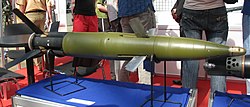Krasnopol (Weapon)
| Krasnopol | |
|---|---|

30F39 Krasnopol guided projectile
|
|
| Type | Guided artillery shell |
| Place of origin | Russia |
| Service history | |
| Used by |
Soviet Army Russian Army |
| Production history | |
| Manufacturer | KBP Instrument Design Bureau |
| Produced | 1986-present |
| Variants | 2K25 Krasnopol 2K25M Krasnopol-M KM-1M Krasnopol-M2 |
| Specifications | |
| Weight | 50 kg (110 lb) |
| Diameter | 152 mm and 155 mm |
|
|
|
| Caliber | 152 mm and 155 mm |
| Effective firing range | 40 kilometres (25 mi) |
| Warhead | High Explosive |
| Warhead weight | 20 kg (45 lb) |
|
|
|
|
Guidance
system |
laser guidance |
The 30F39 Krasnopol is a Russian 152/155 mm cannon-launched, fin-stabilized, base bleed-assisted, semi-automatic laser-guided, explosive projectile. It automatically 'homes' on a point illuminated by a laser designator, typically operated by a ground-based artillery observer. It is intended to engage small ground targets such as tanks, other direct fire weapons, strong-points, or other significant point targets visible to the observer. It can be used against both stationary and moving targets (providing these remain within the observer's field of view).
In February 1986 the Krasnopol system was adopted by the Soviet Army and began mass production in Izhmash and Izhmeh factories. Since 2002 it is augmented by the 120-122 mm Kitolov-2 laser-guided system.
The 2K25 Krasnopol system consists of the 30F39 guided shell; a 1D22, 1D20, or 1D15 laser target designator (LTD); and the 1A35 shot synchronization system. The laser designation system has a range of 5 km (3.1 mi), while the projectile itself has a range of 20 km (12 mi) and a target seeker radius of 1 km (0.62 mi).
The system functions as follows. The observer determines the target location (e.g. map coordinates or bearing and distance from their own position), ensures that their laser target designator can 'mark' the target and requests or orders a fire mission against the target using Krasnopol. A gun is then aimed at the target location and a guided shell is fired. The firing unit uses their 1A35K command device to send a signal via a communications link confirming the firing of the projectile to the 1A35I observation post device with the observer. The laser target designator is then used to illuminate the target and the in-flight shell detects the laser energy reflected by the target and 'homes' on the point of reflection, the designated target.
After destruction of the initial target, the LTD operator may request or order another target. If these subsequent targets are close together they should be upwind (from the previous target) to reduce smoke and dust interference with the designator.
Krasnopol is capable of hitting targets moving at speeds up to 36 km/h (22 mph).
The original model of the Krasnopol was designed to be used with former Soviet-Bloc artillery systems of 152 mm (6.0 in), such as D-20, 2S3 Akatsiya, 2A65 (Msta-B). Krasnopol carries a 20.5 kg (45 lb) high explosive fragmentation warhead. The entire missile weighs 50 kg (110 lb). However, its length made it incompatible with the autoloader of the 2S19 152mm Self-Propelled Gun.
...
Wikipedia
